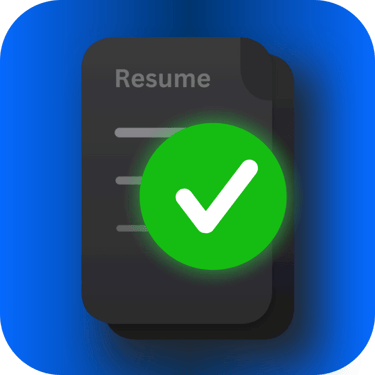Why Your Creative Resume Gets Ignored
7/27/20253 min read
A link to a professional portfolio is considered a must-have for 56% of hiring managers in creative fields.
As a creative, your portfolio is your masterpiece. It’s a vibrant gallery showcasing your best work, your unique style, and your brilliant ideas. It’s where your talent truly lives. Your resume? That's the little museum label next to the art.
And here’s the problem: if that label is boring, generic, or written in a language the curator doesn't understand, they might walk right past your masterpiece without ever giving it a second glance.
In creative industries, your resume has one primary job: to make the hiring manager desperate to click the link to your portfolio. A generic resume doesn't just fail; it sends a message that you don’t understand branding, audience, or storytelling—the very skills you’re trying to sell. Here’s how to write a label that does your art justice.
Step 1: Your summary is your "artist's statement"
Forget the dry, corporate objective. Your summary should be a concise version of your creative philosophy, tailored to the company's brand voice. It should tell them who you are as a creative person and what you believe in.
Before (Generic designer):
Graphic designer with experience in branding and digital media. Seeking a creative role.After (Tailored for a minimalist skincare brand):
A minimalist Visual Designer who believes that clean, intentional design can create powerful brand stories. Specializing in creating elegant, user-centric digital experiences for modern e-commerce brands, with expertise in Figma and the Adobe Creative Suite.
Step 2: Turn your bullet points into mini case studies
No one wants to read "responsible for creating logos." They want to know the story behind the work. Frame each project like a mini case study: What was the brief? What was your solution? What was the impact?
Before (Generic writer):
Wrote blog posts for the company website.After (Highlighting a case study):
Pitched and wrote a 12-part blog series on sustainable living, aligning with the brand's eco-friendly mission. The series increased organic traffic by 40% and became the top lead-generating content for Q3.
Step 3: Your skills section is your "creative toolkit"
This is where you list your arsenal. Be specific and match the tools they list in the job description. A generic list looks lazy; a specific one looks prepared.
For a designer: Don't just say "Adobe Suite." List it out: "Photoshop, Illustrator, InDesign, After Effects." Add other tools they ask for like "Figma, Sketch, Webflow."
For a writer: Go beyond "Writing." Use keywords like "UX Writing, Long-Form Content, SEO Copywriting, Scriptwriting, AP Style."
Step 4: Make your portfolio the undeniable star
This is non-negotiable. Your resume is the opening act; your portfolio is the headliner. Make the link to your portfolio impossible to miss. Put it in your contact information section at the very top, right under your name and email. Make it a clean, clickable hyperlink (e.g., yourname.com or yourname.myportfolio.com).
The creative's paradox: the hate for admin
Let’s be honest. You got into this field to create, not to spend hours translating your beautiful, visual, or narrative work into sterile, black-and-white bullet points. The process can feel like a chore that drains your creative energy. It's the exact opposite of the work you love to do.
This is why so many creatives settle for a generic resume, hoping their portfolio will do all the talking. But it often never gets the chance.
The tool that handles the "boring" stuff
Think of the TailorMyResume iOS app as your personal studio manager. It handles the administrative task of resume writing so you can get back to creating.
Our app analyzes the job description to understand the brand's voice and the specific skills they need. It helps you translate your creative projects into the achievement-driven, professional language that hiring managers and ATS systems require. It helps you write the perfect museum label, ensuring everyone stops to admire your work.
Stop letting a boring document hide your brilliant portfolio.
Ready to create a resume that’s as compelling as your work? Download TailorMyResume from the App Store and let us build the bridge to your portfolio.


